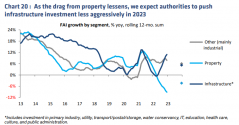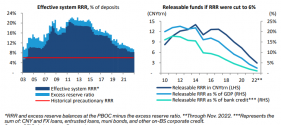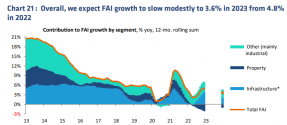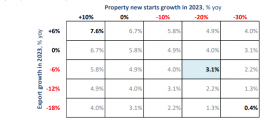Global oil demand in 2023 is expected to grow by around 1.7 million bpd, of which 50% will be driven by China, according to ING, which says “There could be some upside risk to this” forecast.
Despite the current Covid wave, China is preparing for the re-opening with the issuance of a for its private refiners.
“As China’s infection rate slows post-Chinese New Year, we see domestic oil demand rebounding. As the population hits the roads and the skies, our expectation is Chinese oil consumption in 2023 will increase by around 1.0 million b/d, an impressive performance considering Q1 demand is likely to contract by 190,000 b/d,” Gavin Thompson, Vice Chairman, Energy – Asia Pacific, at Wood Mackenzie, on Thursday.
“Look for a particularly bullish Q2, with China adding 1.36 million b/d over the same quarter in 2022, the strongest growth in over a decade (excluding the post-Covid bounce) that will support higher prices,” Thompson added.
You are using an out of date browser. It may not display this or other websites correctly.
You should upgrade or use an alternative browser.
You should upgrade or use an alternative browser.
Chinese Economics Thread
- Thread starter Norfolk
- Start date
By the numbers: The de-dollarization of global trade
Data suggests that US dollar reserves in central banks are dwindling, as is the influence of the US on the world economy. This presents a unique opportunity for regional currencies and alternative payment systems to enter the vacuum.
Data suggests that US dollar reserves in central banks are dwindling, as is the influence of the US on the world economy. This presents a unique opportunity for regional currencies and alternative payment systems to enter the vacuum.
The imposition of US trade restrictions and sanctions against a number of nations, including Russia, Iran, Cuba, North Korea, Iraq, and Syria have been politically ineffectual and have backfired against western economies. As a result, the US dollar has been losing its role as a major currency for the settlement of international business claims.
Because they do not adhere to the policies of the US and other western powers, over 24 countries have been the target of unilateral or partial trade sanctions. These limitations, nevertheless, have turned out to be detrimental to the economies of the Group of Seven (G7) nations and have begun to impact the US dollar’s hegemony in world trade.
In its space, a “new global commercial bloc” has risen to the fore, while alternatives to the western SWIFT banking messaging system for cross-border payments have also been created.
Geopolitical analyst Andrew Korybko tells The Cradle that the west’s extraordinary penalties and seizure of Russian assets abroad broke faith in the western-centric paradigm of globalization, which had been declining for years but had nonetheless managed to maintain the world standard.
“Rising multipolar countries sped up their plans for de-dollarization and diversification away from the western-centric model of globalization in favor of a more democratic, egalitarian, and just one – centered on non-western countries in response to these economic and financial disturbances,” he adds.
Dwindling dollar reserves
The International Monetary Fund (IMF) recorded a decline in central bank holdings of US dollar reserves during the fourth quarter of 2020—which went from 71 percent to 59 percent—reflecting the US dollar’s waning influence on the world economy.
And it continues to worsen: Evidence of this can be seen in the fact that the bank’s holdings of dollar claims have decreased from $7 trillion in 2021 to $6.4 trillion at the end of March 2022.
According to the Currency Composition of Official Foreign Exchange Reserves (COFER) report by the IMF, the percentage of US dollars in central bank reserves has decreased by 12 percent since 1999, while the percentage of other currencies, particularly the Chinese yuan, have shown an increasing trend with a 9 percent rise during this period.
The study contends that the role of the dollar is waning due to competition from other currencies held by the bankers’ banks for international transactions – including the introduction of the euro – and reveals that this will have an impact on both the currency and bond markets if dollar reserves continue to shrink.
Alternative currencies and trade routes
To boost global commerce and Indian exports, the Reserve Bank of India (RBI) devised in July last year a rupee-settlement mechanism to fend off pressure on the Indian currency in the wake of Russia’s invasion of Ukraine and US-EU sanctions.
India has recently concluded agreements for currency exchanges of $75.4 billion with the UAE, Japan, and various South Asian nations. New Delhi has also informed South Korea and Turkey of its non-dollar-mediated exchange rates for each country’s currency. Currently, Turkey conducts business utilizing the national currencies of China (yuan) and Russia (ruble).
Iran has also proposed to the Shanghai Cooperation Organization (SCO) a euro-like SCO currency for trade among the Eurasian bloc to check the weaponization of the US dollar-dominated global financial system.
Mehdi Safari, Iran’s deputy foreign minister for economic diplomacy, informed the media earlier in June last year that the SCO received the proposal nearly two months ago.
“They must use multilateral institutions like BRICS and the SCO to this aim – and related ones, such as currency pools and potentially even the establishment of a new currency whose rate is based on a basket of their currencies, to mitigate the effects of trade-related restrictions,” Korybko remarked.
The International North-South Transport Corridor (INSTC) is being revived as a “sanctions-busting” project by Russia and Iran. The INSTC garnered renewed interest following the “sanctions from hell” imposed by the west on Moscow. Russia is now finalizing regulations that will allow Iranian ships free navigation along the Volga and Don rivers.
The INSTC was planned as a 7,200 km long multimodal transportation network including sea, road, and rail lines to carry freight between Russia, Central Asia, and the Caspian regions.
Ruble-Yuan Payment System
On 30 December, 2022, Russian President Vladimir Putin and his Chinese counterpart Xi Jinping held a video conference in which Putin reported that bilateral trade between the two countries had reached an all-time high with a 25 percent growth rate and that trade volumes were on track to reach $200 billion by next year, despite western sanctions and a hostile external environment.
Putin stated that there had been a “substantial growth in trade volumes” between January and November 2022, resulting in a 36 percent increase in trade to $6 billion. It is likely that the $200 billion bilateral trade target, if achieved by next year, will be conducted in Russian rubles and Chinese yuan, even though the details of the bilateral trade settlement were not specified in the video conference broadcast.
This is because Moscow and Beijing have already set up a cross-border interbank payment network similar to SWIFT, increased their gold purchases to give their currencies more stability, and signed agreements to swap national currencies in several regional and bilateral deals.
In addition, both Russia and China appear to have anticipated a potential US seizure of their financial assets, and in 2014 they collaborated on energy-centered treaties to strengthen their strategic trade links.
In 2017, the ruble-yuan “payment against payment” system was implemented along China’s Belt and Road Initiative (BRI). In 2019, the two countries signed an agreement to replace the dollar with national currencies in cross-border transactions and converted their $25 billion worth of trade to yuan (RMB) and rubles.
Independence from the dollar
This shift decreased their mutual reliance on the dollar, and currently, just over half of Russia’s exports are settled in US dollars, down from 80 percent in 2013. The bulk of trade between Russia and China is now conducted in local currencies.
Xinjiang in western China has also established itself as a key cross-border settlement center between China and Central Asia, making it a major financial hub in the region. Cumulative cross-border yuan settlement handled in Xinjiang exceeded 100 billion yuan ($14 billion) as early as 2013 and reached 260 billion yuan in 2018.
According to analyst Korybko, significant progress has been made in reducing reliance on the US dollar in international trade, but there is still much work to be done. He notes that the US is not likely to simply accept the challenges to its financial hegemony and is more likely to act to defend it.
“For this reason, it is expected that the US will try to enlist the support of key players by offering them preferential trade deals or the promise of such deals, while simultaneously stoking tensions between Russia, China, India, and Iran through information warfare and possibly threatening to tighten its secondary sanctions regime as ‘deterrence’.”
Eurasian Economic Union
Russia has been working to establish currency swap agreements with a number of trading partners, comprising the five-member Eurasian Economic Union (EEU), which includes Russia, Armenia, Belarus, Kazakhstan, and Kyrgyzstan.
These agreements have enabled the Russian Federation to conduct over 70 percent of its trade in rubles and other regional currencies. With a population of 183 million and a GDP over $2.2 trillion, the EEU poses a formidable challenge to western hegemony over global financial transactions.
Iran and the EEU have recently concluded negotiations on the conditions of a free trade agreement covering over 7,500 categories of goods. When the next Iranian year begins on 21 March, 2023, a market with a potential size of 700 billion dollars will become available for Iranian goods and services.
BRICS is driving de-dollarization
The trend towards de-dollarization in international trade, particularly among the BRICS nations, has gained significant momentum in recent years – together they represent 41 percent of the world’s population, 24 percent of its GDP, and 16 percent of its commerce
In 2015, the BRICS New Development Bank, recommended the use of national currencies in trade. Four years later, the bank provided 25 percent of its $15 billion in financial assistance in local currencies, and plans to increase this to 50 percent in the coming years.
This shift towards de-dollarization is an important step for emerging economies as they seek to assert their role in the global economic system and reduce their reliance on the US dollar. While the adoption of de-dollarization may present some challenges and uncertainties, it is an important step towards a more diverse and balanced global economy.
Yes, I discussed this in another thread I think.
Quite an interesting move here. They are opening up several refineries (recently signed agreement with Saudis). In return for importing more oil, they are also exporting more refined oil
so they are appearing to take advantage of access to cheap oil from Russia and Iran.
new refineries opening.
What this imo does is:
1) Increases its position as the world's largest oil importer and gives it negotiating power vs all exporters
2) Gives them flexibility to import more if exporters meet their demand since they don't actually need to export refined oil product
3) That flexibility could be used to encourage greater usage of RMB settlement and their own energy trading exchanges/platforms.
4) Create jobs for refineries that can then make huge profit on export of gasoline & diesel
5) Cause refineries to go out of business in other countries since they won't be able to compete on pricing. Note that America is China's biggest importer of diesel oil. Of course, other countries could see lower refinery capacity for different reasons.
I think everyone agrees that 2023 is going to be a good year for the economy. The real question is what happens in 2024 and beyond. For how much longer will 5% annual growth be sustainable? Hopefully, world trade will reduce this year due to a mild recession in the west but this will be compensated for by the post pandemic bouncing back in China. In 2024, trade will recover and China can have more export driven growth.
Now that China is richer than Thailand and Brazil, I expect an export boom from them to the West while China reduces its exposure to hostile markets
Many countries in the middle income trap were just unfortunate to be at the same level of development as China when China re-entered the world economy. South Korea was just advanced enough to continue profiting from trade with China, but countries like Thailand, Indonesia, Brazil and Mexico were all competing with China in cheap manufactured goods. They lost a lot of export market share to China and therefore got stuck at their current level of income. The good news for them is that today China is ahead of them. While China moves into advanced electronics and EVs etc garments and simple assembly work can go to other countries and they will also be able to produce for the Chinese market. And don't forget West Asia, which is quickly growing more peaceful and prosperous as malign US influence recedesVietnam is doing great - but it's the GDP of Heilongjiang with the population of Henan.
Singapore is great, it's got the population of Chaoyang district in Beijing.
India's also big and growing, but it's base is so small that it doesn't move the needle globally. Majority of Indians consume similarly to Sub-Sahara Africa (see my comment on Africa below).
Brazil central bank overnight rate is 13% - inflation is running hotter than that.
A friend visited Indonesia to look at 'great investment opportunities' and came back saying that consumers are struggling.
Peru just had a coup, Chile is okay, but it's population smaller than Beijing.
Africa - sure, lots of people but they barely can feed themselves.
What you need to understand is that the Global South doesn't matter *today*, economically speaking. Global GDP is ~100 trln USD, top 20 economic entities account for about 80 trln of that 100 trln. Wake me up in a decade when Belt and Road starts to work out and their economies start growing.
View attachment 105052
Folks, if you're living in North America feeling the grocery bills - it's not like basic commodities aren't globally fungible goods that don't have the same prices - people in the global south are struggling 5-10x worse than you are.
Now that China is richer than Thailand and Brazil, I expect an export boom from them to the West while China reduces its exposure to hostile markets
I think everyone agrees that 2023 is going to be a good year for the economy. The real question is what happens in 2024 and beyond. For how much longer will 5% annual growth be sustainable? Hopefully, world trade will reduce this year due to a mild recession in the west but this will be compensated for by the post pandemic bouncing back in China. In 2024, trade will recover and China can have more export driven growth.
Many countries in the middle income trap were just unfortunate to be at the same level of development as China when China re-entered the world economy. South Korea was just advanced enough to continue profiting from trade with China, but countries like Thailand, Indonesia, Brazil and Mexico were all competing with China in cheap manufactured goods. They lost a lot of export market share to China and therefore got stuck at their current level of income. The good news for them is that today China is ahead of them. While China moves into advanced electronics and EVs etc garments and simple assembly work can go to other countries and they will also be able to produce for the Chinese market. And don't forget West Asia, which is quickly growing more peaceful and prosperous as malign US influence recedes
Now that China is richer than Thailand and Brazil, I expect an export boom from them to the West while China reduces its exposure to hostile markets
Keep in mind that it took Europe several years (much longer than US) to recover from GFC.
Japan's real GDP for 2022 is #4.3 trillion, which is lower than what it was in 1993
British economy did not recover to 2007 level in USD until 2021.
German economy did not recover to 2008 level in USD until 2014.
French economy did not recover to 2008 level in USD until 2021.
Italian economy for 2022 is $400 billion less than 2008 (so about 16% less)
natural resources based economy did recover sooner.
So, I'm not convinced by @abenomics12345 argument that China's economy is really that dependent on Western economy recovery. I think they can make continued gains by selling more industrial goods/tools to natural resource countries and rest of global south. China's trade with US hasn't grown in real terms for several years. Although one could argue that was just shifted to go through Mexico or ASEAN countries.
I think the successful implementation of RCEP, more connectivity with Latin America and much higher trade volume to natural resources countries is the main growth engine for them.
Remember, they have one major advantage for the foreseeable future and that is cheap energy.
I think this ability to get cheap energy and then re-export refined products is a nice arbitrage to be running. Also, this kind of stuff increases the dependence that rest of the world has to them.
actually, there is an article on this subject on Bloomberg, since it's paywalled, I got this from TASSYes, I discussed this in another thread I think.
Quite an interesting move here. They are opening up several refineries (recently signed agreement with Saudis). In return for importing more oil, they are also exporting more refined oil
so they are appearing to take advantage of access to cheap oil from Russia and Iran.
new refineries opening.
What this imo does is:
1) Increases its position as the world's largest oil importer and gives it negotiating power vs all exporters
2) Gives them flexibility to import more if exporters meet their demand since they don't actually need to export refined oil product
3) That flexibility could be used to encourage greater usage of RMB settlement and their own energy trading exchanges/platforms.
4) Create jobs for refineries that can then make huge profit on export of gasoline & diesel
5) Cause refineries to go out of business in other countries since they won't be able to compete on pricing. Note that America is China's biggest importer of diesel oil. Of course, other countries could see lower refinery capacity for different reasons.
This is the arbitrage I'm thinking of. China gets cheap oil from Iran & Russia and then refined it, before exporting the extra to Europe."China policy is the game changer," Williams said. The country "holds the key to all of the surplus refining capacity globally," he noted.
Exports of diesel-type fuel from China could range from 400,000 to 600,000 barrels daily during the first six months of this year, the expert said. This a similar volume to what the EU and UK currently stand to lose in terms of seaborne deliveries from Russia, Williams noted.
"There’s a total re-jigging in terms of diesel trade flows from the start of February," he added.
According to Vortexa, the EU imported about 220 mln barrels of diesel fuel from Russia last year, Bloomberg said.
For dollar value.
China exported about $2 billion in diesel in Nov after $1 billion in Oct.
based on this, they export 1.06 million ton of diesel in October -> 7.7 million barrel
That works out to be around $130 per barrel of diesel.
If we extrapolate that to 150 million barrel of additional diesel they export to Europe, that's about $20 billion. I don't think they will actually end up exporting that much diesel, but I do see a lot more refined oil export.
Last edited:
I did a little more math here
From this December article, refining margins keep getting better with the current Russian oil cap
So then, you have China importing oil at like $50 to $60 and reselling it at $120 to $130 per barrel. From which, it makes $70 per barrel. Some of that goes straight to profit (lets say $20), others go to Chinese shipping & insurance company (since Western companies will no longer ship or insure Russian oil), others will go pay for the Chinese workers in the refineries and great profit at the Chinese shipyard. So effectively, China gets up to $70 PnL to its economy per refined/flipped barrel of oil. That additional profit will also have secondary effect in supporting other sectors of the economy.
And if this forces more countries to trade on Shanghai exchanges for refined oil product and crude, it will also support greater RMB internationalization and more fees for Chinese trading exchanges.
From this December article, refining margins keep getting better with the current Russian oil cap
That works out to be about $17 per barrel using the most recent exchange rate. This could go up even more as the Europeans loose access to cheap Russian refined product in February.The flow of cheaper Russian crude to China lifted the refining margins of the independent refiners, the so-called teapots, to above $115 (800 Chinese yuan) per ton last week, from less than $86 (600 yuan) at the beginning of December
So then, you have China importing oil at like $50 to $60 and reselling it at $120 to $130 per barrel. From which, it makes $70 per barrel. Some of that goes straight to profit (lets say $20), others go to Chinese shipping & insurance company (since Western companies will no longer ship or insure Russian oil), others will go pay for the Chinese workers in the refineries and great profit at the Chinese shipyard. So effectively, China gets up to $70 PnL to its economy per refined/flipped barrel of oil. That additional profit will also have secondary effect in supporting other sectors of the economy.
And if this forces more countries to trade on Shanghai exchanges for refined oil product and crude, it will also support greater RMB internationalization and more fees for Chinese trading exchanges.
To begin, any number that doesn't start with a trillion RMB literally won't matter in terms of the grand scheme of GDP growth. We can talk about industrial upgrade but that isn't really this discussion.
Some aggregate data to keep the discussion grounded in reality:
Chinese economy was 115trln RMB in 2021 and will most likely be ~119trln RMB in 2022 (assuming a little more than ~3% growth) - billions here or there won't move the grand scheme of things.
2021 Economic Data - Big Accounts - Not calculating C+G+I+(X-M), just laying out what will move the needle.
Retail Sales - 44 trln
FAI - 54.5 trln (Real estate was ~20 trln)
Export - 21.7 trln
Import - 17.4 trln

This is the result of the Shanghai lockdown - it was bad. As a result of the 3RL + poor consumer sentiment/income expectations, we all knew what happened to real estate:

And the Chinese economy was kept afloat by the significant stimulus of Fixed Asset Investment (FAI), largely in the infrastructure account (government - both local and central), as well as tax cuts/stimulus.

Additionally, government has cut significant taxes in 2020-2022 - probably has already used up all the policy tools here - we are back to 2000 in terms of tax as % of GDP.
Furthermore, PBoC is likely constrained as they've already cut RRR/LPR quite a bit - as well, liquidity only helps when credit demand is high - right now the problem is low credit demand (TSF took a nosedive in Q4 2022)

So how does 2023 look like:
Retail sales is most likely negative for 2022 vs 2021 - so a reasonable assumption is some recovery (as ZCP goes away and consumption occasions come back)
- Exports will be bad - December data was just released today and exports turned negative - keep in mind exports grew 21% in 2021 and has been on a downward path since.
- FAI will be still positive, but less positive vs. 2022 - while property investment might stabilize at some 13trln RMB (vs a peak of 20trln in 2021), infrastructure investments will also be weaker as a result of constrained local government finances.

(There is some ~65 trln of LGFVs - nobody knows how much of it is money good - it might be rolled as we saw with Zunyi Road & Bridge with ridiculous terms like 20 year extension with 10 year PIK, but let's just say markets are not buying more - before anyone says MMT - do I need to remind people of the inflation we are seeing globally in DM countries?)
Assuming an 8% retail sales growth, and assuming infrastructure to grow with a healthy clip, this is the sensitivity analysis on GDP growth for 2023 (that 3.1 is real, so add some inflation to get to nominal).

Look, to be clear, 4-6% growth in 2023 for China is amazing compared to the rest of the world. But China is literally the cleanest shirt in a dirty laundry pile in the world - not the shining beacon of global growth it was in 2010s.
All the excitement in EVs, clean energy, biotech, semiconductors are all great, but they are literally rounding error in the grand scheme of things - we need trillions to grow the pile.
I'd like to see someone push back on how this is higher in 2023 with trillions- not 10s of billions.
Edit: all historical data is from Wind/CEIC - you can ignore the forecasts but they're from Autonomous Research.
Some aggregate data to keep the discussion grounded in reality:
Chinese economy was 115trln RMB in 2021 and will most likely be ~119trln RMB in 2022 (assuming a little more than ~3% growth) - billions here or there won't move the grand scheme of things.
2021 Economic Data - Big Accounts - Not calculating C+G+I+(X-M), just laying out what will move the needle.
Retail Sales - 44 trln
FAI - 54.5 trln (Real estate was ~20 trln)
Export - 21.7 trln
Import - 17.4 trln

This is the result of the Shanghai lockdown - it was bad. As a result of the 3RL + poor consumer sentiment/income expectations, we all knew what happened to real estate:

And the Chinese economy was kept afloat by the significant stimulus of Fixed Asset Investment (FAI), largely in the infrastructure account (government - both local and central), as well as tax cuts/stimulus.

Additionally, government has cut significant taxes in 2020-2022 - probably has already used up all the policy tools here - we are back to 2000 in terms of tax as % of GDP.
Furthermore, PBoC is likely constrained as they've already cut RRR/LPR quite a bit - as well, liquidity only helps when credit demand is high - right now the problem is low credit demand (TSF took a nosedive in Q4 2022)

So how does 2023 look like:
Retail sales is most likely negative for 2022 vs 2021 - so a reasonable assumption is some recovery (as ZCP goes away and consumption occasions come back)
- Exports will be bad - December data was just released today and exports turned negative - keep in mind exports grew 21% in 2021 and has been on a downward path since.
- FAI will be still positive, but less positive vs. 2022 - while property investment might stabilize at some 13trln RMB (vs a peak of 20trln in 2021), infrastructure investments will also be weaker as a result of constrained local government finances.

(There is some ~65 trln of LGFVs - nobody knows how much of it is money good - it might be rolled as we saw with Zunyi Road & Bridge with ridiculous terms like 20 year extension with 10 year PIK, but let's just say markets are not buying more - before anyone says MMT - do I need to remind people of the inflation we are seeing globally in DM countries?)
Assuming an 8% retail sales growth, and assuming infrastructure to grow with a healthy clip, this is the sensitivity analysis on GDP growth for 2023 (that 3.1 is real, so add some inflation to get to nominal).

Look, to be clear, 4-6% growth in 2023 for China is amazing compared to the rest of the world. But China is literally the cleanest shirt in a dirty laundry pile in the world - not the shining beacon of global growth it was in 2010s.
All the excitement in EVs, clean energy, biotech, semiconductors are all great, but they are literally rounding error in the grand scheme of things - we need trillions to grow the pile.
I'd like to see someone push back on how this is higher in 2023 with trillions- not 10s of billions.
Edit: all historical data is from Wind/CEIC - you can ignore the forecasts but they're from Autonomous Research.
I'd like to see someone push back on how this is higher in 2023 with trillions- not 10s of billions.
Edit: all historical data is from Wind/CEIC - you can ignore the forecasts but they're from Autonomous Research.
We have heard tunes like yours before. How do you come up with 8% retail growth? Why not 1%? 20%?
Chinese government is pushing for house renovations as the next big consumption.
We have heard tunes like yours before. How do you come up with 8% retail growth? Why not 1%? 20%?
Chinese government is pushing for house renovations as the next big consumption.
Yeah because its the facts. 8% is trend growth - it could be 6% or it could be 10% but I would bet a lot of money against 20% retail sales growth in 2023. If you want to make a bet, let me know. Otherwise settle down.
What is the expected boost as a result of what you said re: "house renovations"? How many trillions of RMB?
